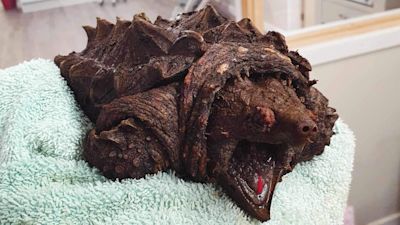‘Invasive’ alligator snapping turtle found in Cumbria and named Fluffy by vets

An “invasive” alligator snapping turtle has been named Fluffy by a vet after being found near a lake in Cumbria.
The animal, which could “certainly give you a nasty nip”, is native to freshwater habitats in North America in states such as Florida and Texas, but was brought to Wild Side Vets in Barrow-in-Furness on Monday.
The turtle was brought to the clinic by a local councillor who wore “three pairs of builders’ gloves” and transported the animal in a shopping basket from Urswick Tarn, a lake in the area.
The species can live for up to 70 years in captivity and can weigh up to 80 - 90 kilograms.
Dr Dom Moule, a vet at Wild Side Vets was there at the time the turtle was brought to the clinic. He has previously worked in a zoo and was able to identify the species.
He said the reptile's jaw, when fully grown, is strong enough to bite through bone.
Dr Kate Hornby, the owner of the clinic and a veterinarian, initially thought it would be a terrapin and was surprised to learn it was an alligator snapping turtle.
“It’s certainly the first one we’ve seen at the clinic – they are kept in the UK but they’re certainly not a common thing you would see at the vets,” Dr Hornby told the PA news agency.
“It would certainly give you a nasty nip and it could probably do significant damage to a finger or finger end, but at this size, it’s not particularly dangerous.”
It is estimated the turtle is around five or six years old, with Dr Hornby adding: “We haven’t been able to identify whether it’s male or female due to its size – but we’re calling it Fluffy for now.”
Dr Hornby said: "I think someone had found it on a dog walk and the community had been getting involved by putting photos on local group pages.
“The local councillor went down and I think she had spent some time in Florida so she recognised what it was.
“I think she’d gone in with three pairs of builders’ gloves on and had put it in a shopping basket to be able to bring it to us.”
Dr Hornby said the turtle requires a source of UV light and warm water temperatures, often in excess of 20C.
She added that the turtle has not been eating since arriving at the clinic because it is potentially in a state of hibernation due to the colder UK climate.
“It was quite muddy when it first came in, it potentially could have been there for quite some time and effectively hibernated,” she said.
“The tarn would not have reached the temperatures it would be used to and would need.”
Dr Hornby said the alligator snapping turtle will be relocated to a specialist reptile centre where it will be put in warmer waters to speed up its metabolism.
She suspected the turtle had been kept as a pet and the owners had struggled to keep up with its care demands or not wanted it any more.
“We don’t often see reptiles at the clinic, and when they do come in, it’s often because the way they have been kept is incorrect,” she said.
“Doing a lot of research into the particular species you’re looking at keeping and making sure you’ve got the appropriate housing and appropriate knowledge is important.
“But if people find that their circumstances have changed and they’re in a position, reach out and speak to your vet.”
Want a quick and expert briefing on the biggest news stories? Listen to our latest podcasts to find out What You Need To Know...